- home
- BAKERECIPES
BakeRecipes
Bringing real baking into your home with deliciously simple recipes.
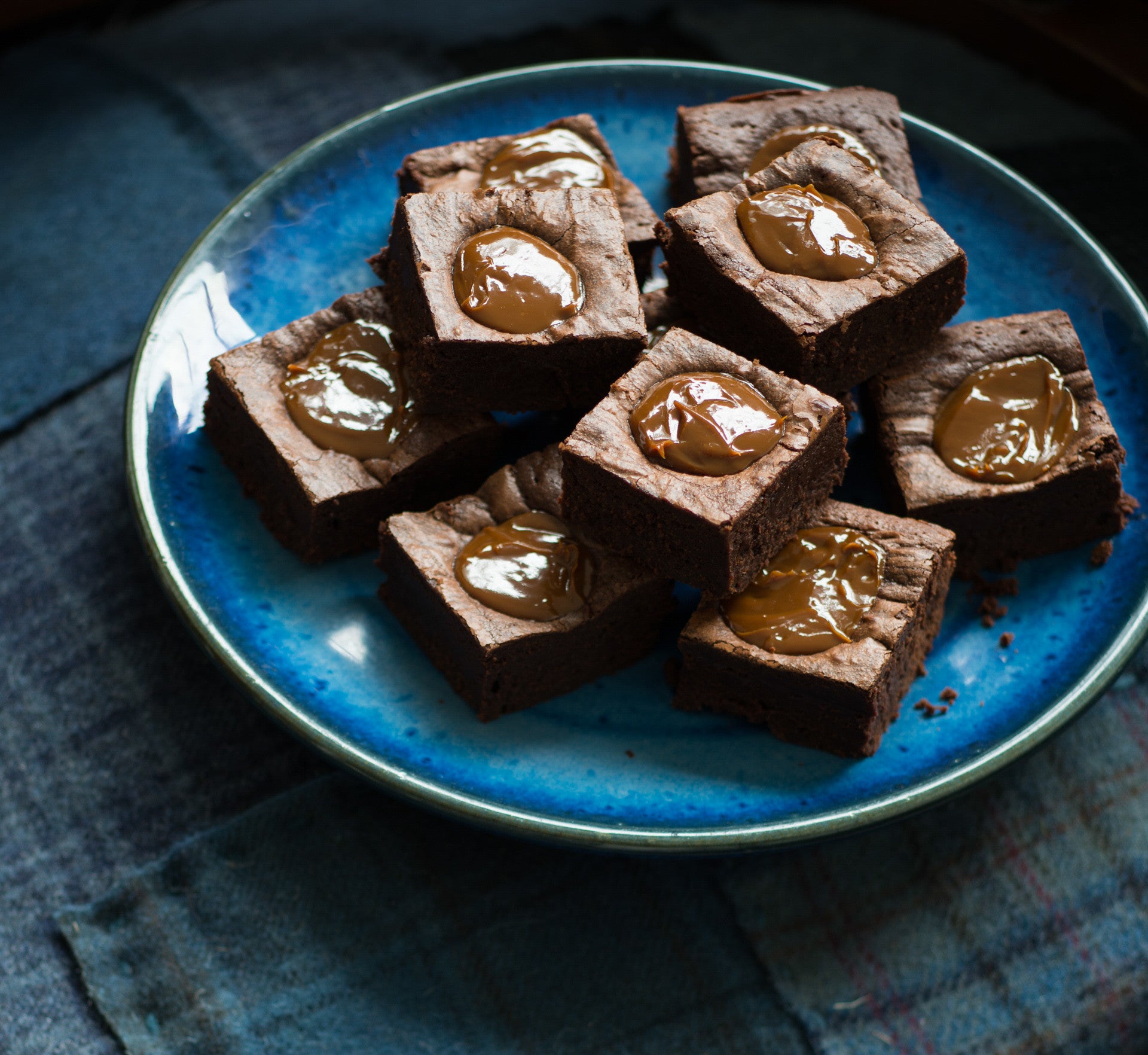
Prep 20min (+2hr cooling time)
Bake 30-35minMakes 15
Brownie lovers, take note: with every portion holding its very own generous dollop of dulce de leche, this is the brownie you have been searching for all your life! For a particularly wicked dessert, serve it drizzled with warmed extra dulce de leche and topped with a generous scoop of vanilla ice-cream.
Ingredients
Melted butter, to grease
250g (9oz) good-quality dark chocolate (45-54% cocoa), chopped
200g (7oz) salted butter, cubed
3 eggs, at room temperature, lightly whisked
165g (¾ cup, firmly packed/5¾oz) brown sugar
1½ teaspoons natural vanilla essence or extract
110g (¾ cup/4oz) plain flour
30g (¼ cup/1oz) cocoa powder
½ teaspoon baking powder
250g (9oz) jar dulce de leche
Cocoa powder or icing sugar (optional), to sprinkle
Method
- Preheat oven to 160°C/315°F (140°C/285°F fan-forced). Grease a 16cm x 26cm (6¼in x 10½in) shallow slice tin with melted butter and line the base and long sides with one piece of baking paper.
- Place the chocolate and butter in a medium heatproof bowl over a saucepan of gently simmering water (don't let the base of the bowl touch the water). Stir occasionally until chocolate and butter melt and the mixture is smooth. Remove bowl from saucepan and set aside.
- Use an electric mixer with a whisk attachment to whisk the eggs and sugar until thick and pale. Add the melted chocolate mixture and vanilla and whisk to combine.
- Sift together the flour, cocoa powder and baking powder. Add to chocolate mixture and whisk on low speed until just combined. Pour mixture into prepared tin and spread evenly with the back of a spoon.
- Dot the brownie mixture with spoonfuls of the dulche de leche, dividing evenly. Tap the tin on the benchtop to settle the mixture. Bake in preheated oven for 30-35 minutes or until moist crumbs cling to a skewer inserted in the brownie part. Remove from the oven and cool in tin on a wire rack (this will take about 2 hours).
- Remove brownie from the tin using the baking paper to lift it out. Cut into portions and sprinkle with cocoa powder or icing sugar to serve, if desired.
Baker's Tip
- These brownies will keep in an airtight container in the fridge, for up to 5 days. Serve at room temperature.
Photography by Alan Benson.

Prep 20minBake 17-20minMakes about 24
Ingredients
1 quantity Shortcrust Pastry, divided into 2 portions before wrapping and chilling
Filling
1½ rashers bacon, trimmed and finely choppedMethod
- With a lightly floured rolling pin, roll out one portion of pastry on a lightly floured surface until about 2mm thick. Use a 7cm round cutter to out 12 circles and then carefully ease them into an ungreased 12-hole mini (1½ tablespoon capacity) muffin tray, pleating the pastry 4-5 times to help shape it. Repeat with the remaining pastry and another 12-hole mini muffin tray to make 24 tartlet cases in total. Use a fork to prick the base of each tartlet case twice. Place the muffin trays in the freezer for at least 30 minutes or until ready to bake.
- Preheat oven to 200°C (180°C fan-forced).
- Meanwhile, to make the filling, cook the bacon in a non-stick frying pan over medium heat for 5 minutes, stirring occasionally, or until starting to crispen. Transfer the bacon to a medium bowl and add the cheese and parsley. Whisk together the egg and cream, add to the bacon mixture and stir with a fork to combine. Season with pepper.
- Bake the unfilled frozen tartlet cases straight from the freezer in preheated oven for 12 minutes or until golden.
- Use a teaspoon to fill each pre-baked tartlet case with a small amount of the the filling, making sure you get a good amount of the bacon, cheese and egg mixture in each. Return to the oven and bake for 5-8 minutes or until the filling is just set.
- Serve warm or at room temperature garnished with a tomato slice, if desired.
Baker's Tips
- You can make these tartlets up to 2 days ahead of serving. Cool and then store in an airtight container in the fridge. Place the tartlets back in the tins before reheating in an oven preheated to 160°C (140°C fan-forced) for 10 minutes or until heated through.
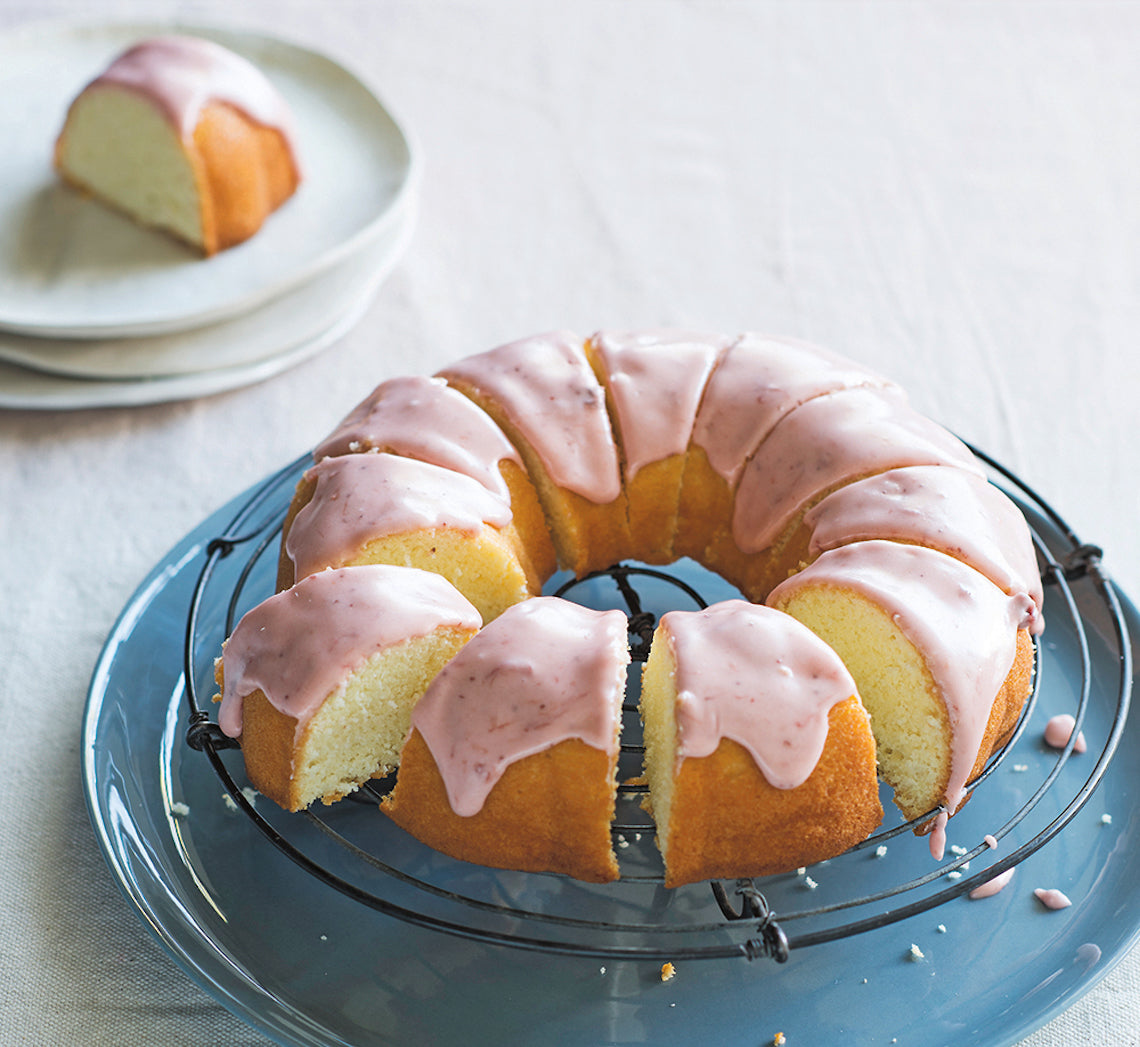
Prep 20min (+ 1hr cooling and 40min standing time)Bake 30minMakes 10 serves
This cake really seems to have its method all mixed up but I promise you it works – and works beautifully, at that!
Ingredients
Melted butter, extra, to grease
220g (1 cup) caster (superfine) sugar
150g (1 cup) plain (all-purpose) flour
1½ tablespoons cornflour (cornstarch)
1 teaspoon baking powder
6 egg whites, at room temperature
100g unsalted butter, melted and cooled
Strawberry icing
125g (1 cup) pure icing (confectioners') sugar
1½ tablespoons smooth strawberry jam
2–2¼ teaspoons water
Method
- Preheat the oven to 180°C (160°C fan-forced). Brush a 2.5 litre (10 cup) capacity fluted ring (bundt) tin with melted butter to grease.
- Sift together the sugar, flour, cornflour and baking powder.
- Use an electric mixer with a whisk attachment to whisk the egg whites on medium or medium–high speed in a clean dry bowl until soft peaks just form.
- Sift the dry ingredients again over the egg whites and use a large metal spoon or spatula to fold until just combined. Pour over the melted butter and fold in until just combined.
- Pour the mixture into the greased tin and smooth the surface with the back of a spoon. Bake in the preheated oven for 30 minutes, or until a skewer inserted in the cake comes out clean. Leave the cake to stand in the tin for 10 minutes before turning out onto a wire rack to cool for about 1 hour.
- To make the Strawberry icing, sift the icing sugar into a medium bowl. Combine the jam and 2 teaspoons of the water, add to the icing sugar and stir until smooth and a thick coating consistency, adding the remaining ¼ teaspoon water if needed.
- Spoon the icing over the cooled cake, allowing it to dribble down the sides. Set aside for about 30 minutes, or until the icing is set. Serve in slices.
Baker's Tips
- This cake will keep in an airtight container at room temperature for up to 3 days.
- You can replace the strawberry jam with another jam of your choice – blackberry, raspberry and plum all work well.

Prep 40min (+1.5hr proving and 20min standing time)Bake 25minMakes about 12
Just milk bread studded with sultanas, topped with pink icing and finished with coconut – it's the simplicity that gives the finger bun its appeal!
Ingredients
375g (2½ cups) strong bread or pizza flour, plus extra, to dust
2 tablespoons caster (superfine) sugar
60g (⅓ cup) sultanas (golden raisins)
7g (1 sachet) dried yeast
½ teaspoon salt
200ml milk
40g butter, cubed
2 eggs, at room temperature
1 teaspoon natural vanilla extract or essence
Melted butter, to grease
185g (1½ cups) pure icing (confectioners') sugar
5 teaspoons water
Pink food colouring (about 3 drops)
2 tablespoons desiccated coconut, to sprinkle
Method
- To make the dough, combine the flour, sugar, sultanas, yeast and salt in a large bowl and make a well in the centre. Combine the milk and butter in a small saucepan and heat over low heat for 2–3 minutes, or until the butter has melted and the milk is lukewarm. Remove from the heat. Whisk one of the eggs with the vanilla and add to the butter and milk mixture. Whisk to combine. Add to the flour mixture. Use a wooden spoon and then your hands to mix to a soft dough.
- Turn the dough onto a lightly floured bench top and knead for 8–10 minutes or until it is smooth and elastic and springs back when you push your finger into it.
- Brush a large bowl with melted butter, to grease. Add the dough, turning it to coat lightly with the butter. Cover with plastic wrap and place in a warm, draught-free place for 1 hour or until doubled in size.
- Preheat the oven to 180°C (160°C fan-forced). Line two baking trays with baking paper.
- When the dough has doubled in size, knock it back by punching it in the centre with your fist. Turn onto a lightly floured bench top and knead for 2–3 minutes or until smooth and elastic. Divide the dough into 12 equal portions. Shape each portion into a long oval shape about 12cm long and 3cm wide in the centre, and place on the lined trays, leaving about 5cm between them. Cover with a slightly damp tea towel (dish towel) and set aside in a warm, draught-free place for 30 minutes or until well risen.
- Whisk the second egg and brush the rolls with it to glaze. Bake in the preheated oven for 25 minutes, swapping the trays halfway through baking, or until the buns are golden and sound hollow when tapped on the base. Transfer to a wire rack to cool.
- To make the Topping, sift the icing sugar into a medium bowl. Use a wooden spoon to stir in the water and mix to a very thick pouring consistency. Add 2–3 drops of pink food colouring to tint the icing. Spread the cooled finger buns with the icing, allowing it to drizzle down the sides. Sprinkle with the coconut and set aside for 20 minutes for the icing to set before serving. These finger buns are best eaten on the day they are made.
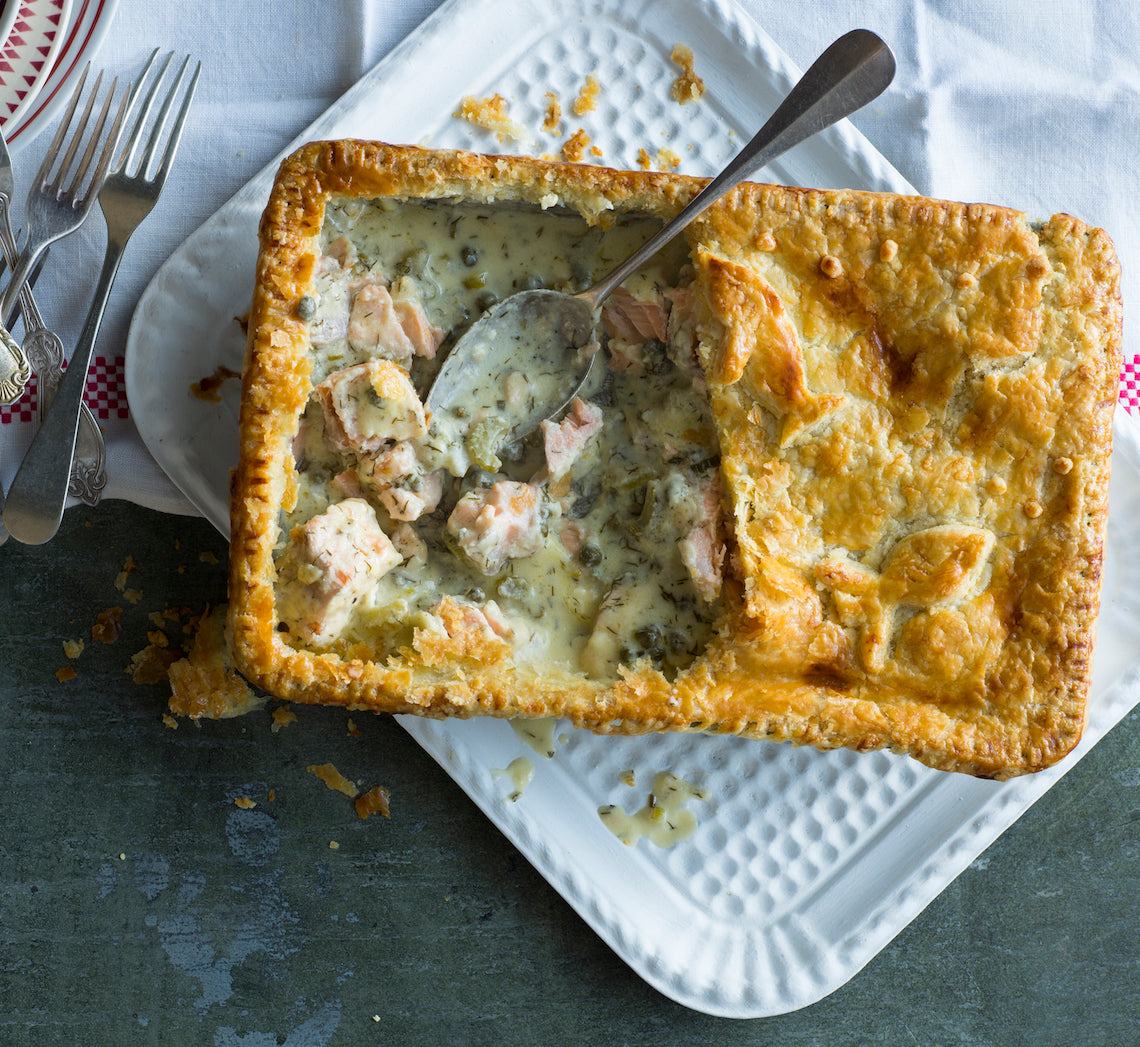
Prep 30min (+ 1hr cooling and pastry making time)Bake 45minMakes 4 serves
On a trip to Finland a few years ago it only took me a couple of meals to realise how much dill and salmon feature in the country’s wonderful cuisine. This pie is a little ode to the Fin’s favourite ingredients, all topped off with a deliciously buttery, flaky pastry.
Ingredients
40g (1½oz) salted butter2 celery stalks, trimmed and sliced
35g (¼ cup/1¼oz) plain flour
250ml (1½ cup/9fl oz) milk
125ml (½ cup/4fl oz) pouring (thin) cream
50g (½ cup/1¾oz) coarsely grated vintage cheddar
3 spring onions, trimmed and sliced
1½ tablespoons (6 teaspoons) baby capers, rinsed and drained
2 tablespoons chopped dill
1 teaspoon Dijon mustard
Salt and freshly ground black pepper, to taste
700g (1lb 8oz) skinless salmon fillets, pin-boned and cut into 3cm pieces
1 quantity Cheat's Rough Puff Pastry
1 egg yolk, lightly whisked with 2 teaspoons milk, to glaze
Method
- Melt the butter in a medium saucepan over medium heat. Add the celery and cook, stirring occasionally, for 5 minutes or until starting to soften. Add the flour and stir with a balloon whisk for about 1 minute until the mixture is bubbling and leaves the sides of the pan.
- Remove the pan from the heat and gradually stir in half the milk, stirring constantly, until smooth. Gradually add the remaining milk and cream, stirring until smooth. Return the pan to medium heat and stir constantly until the sauce thickens and starts to simmer. Reduce the heat to low and simmer, stirring frequently, for 2 minutes.
- Transfer the sauce immediately to a large heatproof bowl and stir in the cheddar, spring onions, capers, dill and mustard. Taste and season well with salt and pepper.
- Place in the fridge for about 1 hour or until cooled to room temperature.
- Preheat the oven to 200˚C/400°F (180°C/350°F fan-forced). You will need a 1.5 litre (6 cup/2pt 10fl oz) capacity ovenproof dish to cook the pie.
- When the sauce has cooled, add the salmon and stir gently to combine evenly.
- Use a lightly floured rolling pin to roll out the pastry on a lightly floured surface to the shape of the dish until about 4mm/⅛in thick. Spoon the cooled salmon mixture into the dish, then brush the edge of the dish with a little of the egg wash. Place the pastry over the filling to cover, then use a small sharp knife to run around the edge of the pie dish on a slight angle to trim the excess pastry. Use a fork to press around the edge of the dish to seal. Cut a cross in the top of the pie and then brush the pastry with a little egg wash to glaze. Decorate the top with the off-cuts of pastry, if desired, and then glaze again with the little of the egg wash.
- Place the pie on a baking tray and bake for 45 minutes or until the pastry is dark golden, crisp and cooked through. Serve straight from the oven.
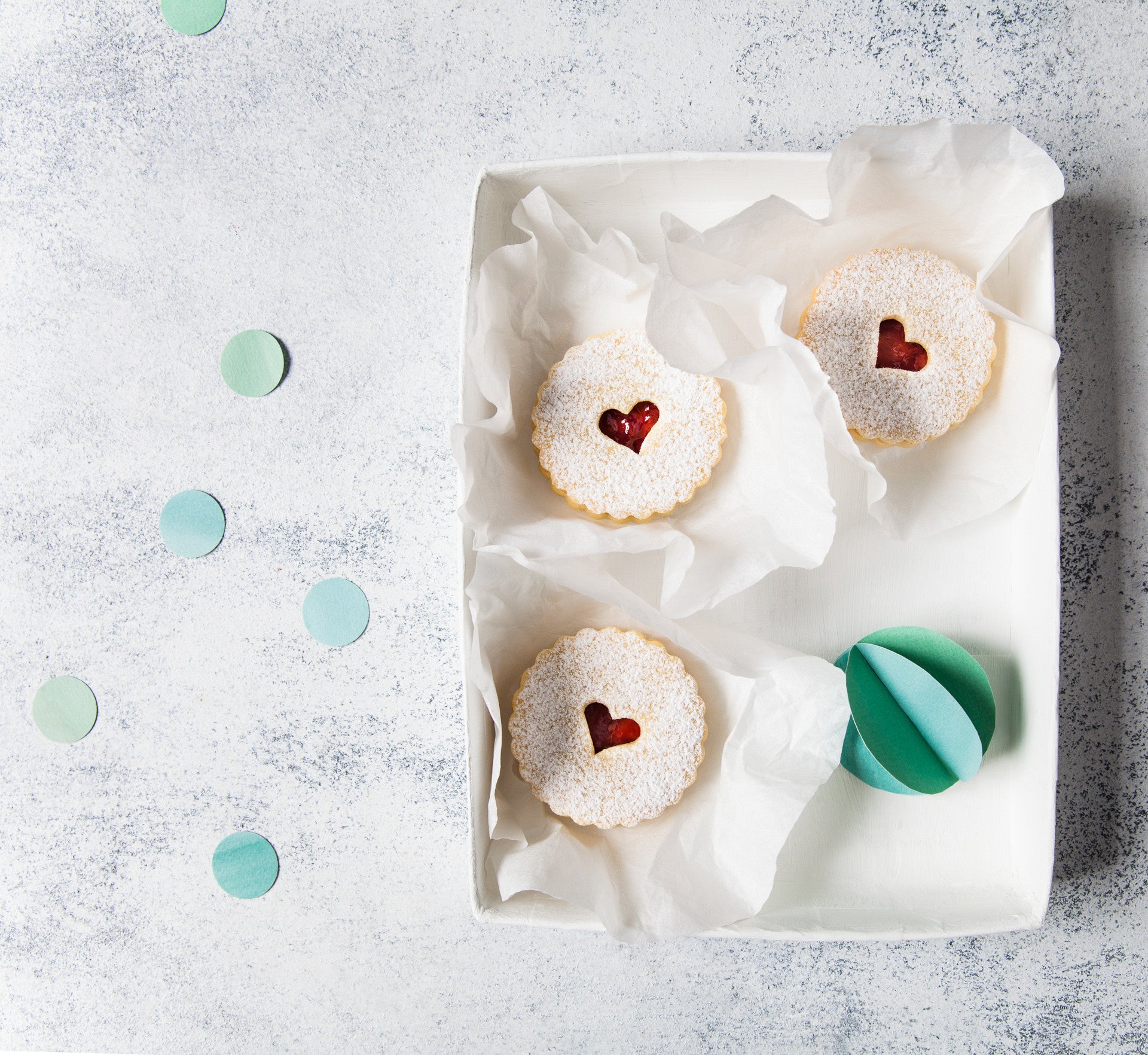
Prep 30min (+ 15min cooling and 30min chilling time)Bake 25-30minMakes about 15
These jammy, Linzer-like, buttery mouthfuls are a popular inclusion in the German Weihnachtsplätzchen (collection of traditional festive cookies) but are often claimed by the Swiss. Feel free to switch up the type of jam you use – red currant is also very traditional.
Ingredients
185g (6½oz) salted butter, at room temperature
110g (½ cup/4oz) caster sugar
1 teaspoon natural vanilla essence or extract
1 egg yolk
300g (2 cups/11¾oz) plain flour
¼ teaspoon fine salt
110g (⅓ cup/4oz) raspberry jam, warmed slightly
Icing sugar, to dust
Method
- Preheat oven to 160°C/315°F (140°C/285°F fan-forced). Line two large oven trays with non-stick baking paper.
- Use an electric mixer with a paddle attachment to beat the butter, sugar and vanilla until pale and creamy. Add the egg yolk and beat well. Sift together the flour and salt. Add to the butter mixture and beat on lowest possible speed until just combined and a soft dough forms.
- Divide the dough in half. Use a rolling pin to roll out one portion of dough between two sheets of non-stick baking paper to 5mm/¼in thick. Use a 6cm/2¼in fluted round cutter to cut out rounds of dough. Use a palette knife to transfer the rounds to the lined trays, leaving about 2cm/¾i between each to allow for spreading. Repeat with the remaining dough portion, re-rolling off-cuts, to make about 30 rounds in total. Place the trays in the fridge for 30 minutes to chill.
- Use a 2cm/¾in heart, fluted round or star-shaped cutter to cut the centre from half of the chilled cookie rounds.
- Bake for 25-30 minutes, swapping the trays halfway through baking, or until pale golden and cooked through. Cool on the trays.
- Spoon 1 teaspoon of the warm jam onto each of the cookie bases and spread to about 1cm/½in from the edge. Dust the cookie tops (with the cut-outs) generously with icing sugar. Carefully sandwich the cookies together, pressing gently to join.
Baker's Tip
- These cookies will keep in an airtight container, layered with baking paper, at room temperature for up to 1 week. Dust with icing sugar again if desired before serving.
This recipe is part of Anneka's SBS Food Bakeproof: Festive Cookies online column. For more Bakeproof columns and recipes, click here.
Photography by China Squirrel.
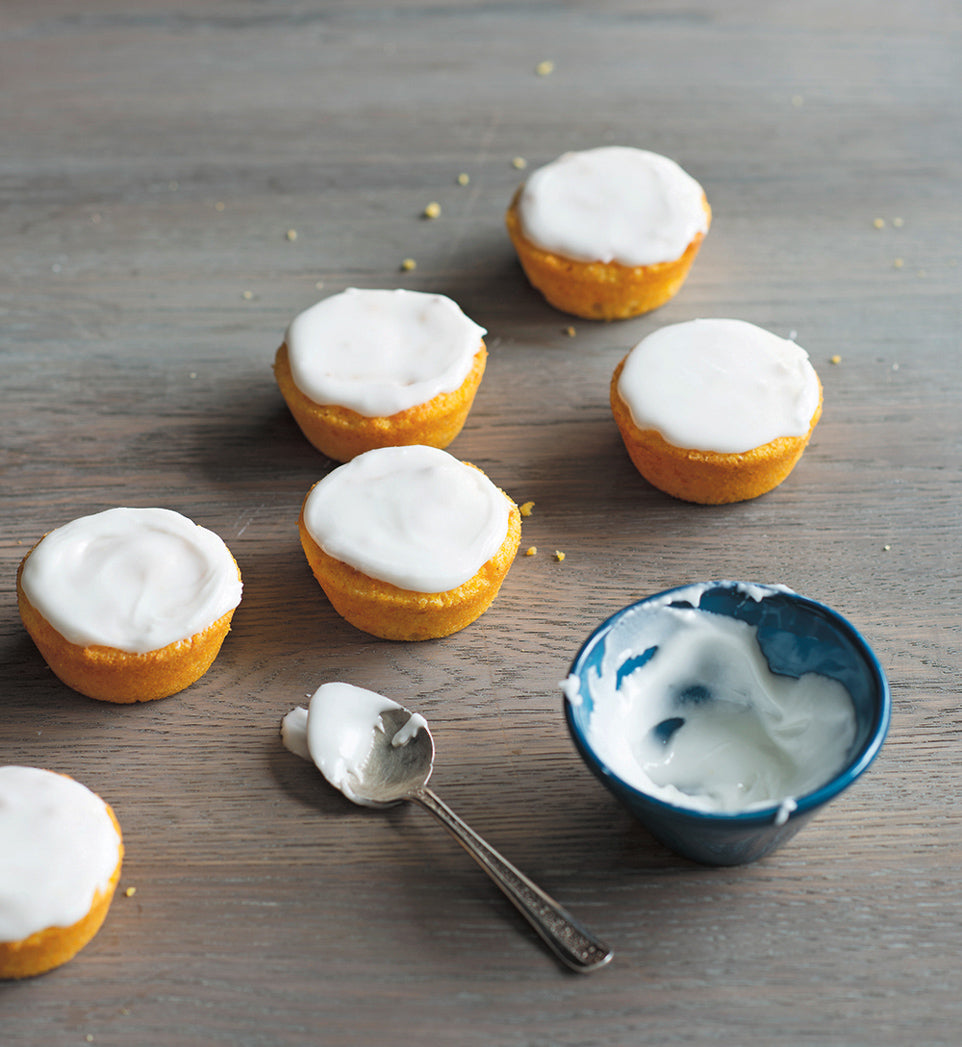
Prep 20min (+ 30-60min simmering, cooling and 20min standing time)Bake 15-18minMakes 12
These cakes are a play on the original (and wonderful) Middle Eastern Orange Cake from the one and only Elizabeth David. Making use of seasonal mandarins and with the addition of coconut and polenta, this version is also flourless and gluten-free.
Ingredients
2 large mandarins (about 110g)
Melted butter, to grease
100g (1 cup) almond meal
95g (½ cup) instant polenta
45g (½ cup) desiccated coconut
½ teaspoon gluten-free baking powder
3 eggs, at room temperature
165g (¾ cup) caster (superfine) sugar
1½ teaspoons natural vanilla extract or essence
250g (2 cups) pure icing (confectioners') sugar
1½–2 tablespoons mandarin juice
Method
- Put the whole mandarins in a small saucepan, cover with water and set over high heat. Bring to the boil, reduce the heat and simmer for 30–60 minutes, or until very soft when tested with a skewer. (You may need to place a small saucer over the mandarins to keep them submerged.) Remove the mandarins from the water and set aside to cool slightly.
- Meanwhile, preheat the oven to 180°C (160°C fan-forced). Brush a 12-hole 80ml (⅓ cup) capacity silicone or metal muffin tin with melted butter to grease. Quarter the mandarins and remove and discard the centre core and any seeds. Purée the skin and flesh in a small food processor or blender until smooth.
- Put the almond meal, polenta, coconut and baking powder in a medium bowl and mix well to combine.
- Put the eggs, sugar and vanilla in a medium bowl and use an electric mixer with a whisk attachment to whisk on high speed until very thick and pale and a ribbon trail forms when the whisk is lifted (about 3–4 minutes).
- Add the mandarin purée to the egg mixture and use a spatula or large metal spoon to fold in until just combined. Add the polenta mixture and fold together until combined. Divide the mixture evenly among the muffin holes (you can pour it from a jug or use a ladle).
- Bake in the preheated oven for 15–18 minutes, or until a skewer inserted in the cakes comes out clean. Cool the cakes in the tin for 5 minutes. Use a palette knife to ease the cakes out and transfer to a wire rack to cool.
- To make the Mandarin icing, sift the icing sugar into a medium bowl. Gradually stir in the juice until the mixture is smooth and has a thick coating consistency, adding a little more juice if too thick. Cover with plastic wrap and set aside at room temperature until ready to use.
- Spread the tops of the cooled cakes with the icing. Set aside for 20 minutes or until set.
Baker's Tips
- These cakes will keep in an airtight container in a cool place (but not in the fridge) for up to 2 days.

Prep 1hr (+30min cooling and 30min standing time)Bake 20minMakes 12
Hailing from the deep south of North America, Lady Baltimore cake is a classic wedding cake choice. With its simple buttercake layers, fruit and nut filling and dreamy meringue frosting, the resulting flavour combination is delightfully complex. These individual cakes are made just for one.
Ingredients
Melted butter, to grease185g butter, softened
145g (⅔ cup) caster sugar, plus 75g (⅓ cup) extra
1 teaspoon natural vanilla essence or extract
1 orange, zest finely grated
225g (1½ cups) plain flour
2 teaspoons baking powder
165ml (⅔ cup) milk
3 egg whites
Filling
45g (¼ cup) raisins, chopped45g (¼ cup) chopped dried figs
2 tablespoons brandy
40g (⅓ cup) chopped toasted walnuts
Meringue Frosting
- 3 egg whites
- 150g (⅔ cup) caster sugar
- 1 teaspoons natural vanilla essence or extract
Method
- Preheat the oven to 180°C (160°C fan-forced). Brush a 12-hole 125ml (½ cup) friand pan with melted butter to grease.
- To make the filling, combine the raisins, figs and brandy in a small saucepan and heat over low heat for 3-5 minutes or until heated through. Remove from the heat and set aside to cool.
- Use an electric mixer to beat the butter, 145g (⅔ cup) caster sugar, vanilla and orange zest, scraping down the sides of the bowl when necessary, until pale and creamy.
- Sift together the flour and baking powder. With the motor running on the lowest possible speed, beat in the flour alternately with the milk, in 2 separate batches each, until just combined.
- In a separate clean dry medium mixing bowl, use a whisk attachment to whisk the egg whites until soft peaks form. Gradually add the extra caster sugar, a spoonful at a time, and whisk on medium-high speed until thick and glossy. Use a large metal spoon or spatula to fold a large spoonful of the egg white mixture through the butter mixture until well combined. Add the remaining egg white mixture and fold until just combined. Divide the mixture evenly among the friand holes and smooth the surfaces. Bake for 20 minutes or until a skewer inserted in the the centre of the cakes comes out clean. Stand the cakes in the tin for 5 minutes before turning out onto a wire rack to cool completely.
- Meanwhile, make the meringue frosting. Choose a medium heatproof mixing bowl that sits snugly on top of a medium saucepan. Quarter-fill the saucepan with water and bring to the boil. Reduce the heat to the lowest possible setting. Put the eggwhites and sugar in the heatproof bowl and place over the simmering water. Use a spatula to stir until the sugar dissolves. (You can tell if the mixture is ready by rubbing a little between your fingers – if it still feels grainy, then continue to stir for another minute or until it no longer feels grainy.) Transfer the mixture to the bowl of an electric mixer and use a whisk attachment to whisk on high speed for 5-8 minutes or until the meringue has cooled to room temperature and is very thick and glossy. Whisk in the vanilla. Transfer two-thirds of the frosting to a bowl, cover with plastic wrap and set aside.
- To finish the filling, transfer the remaining third of the frosting to a medium bowl and fold in the chopped walnuts and the fruit mixture.
- Use a small sharp serrated knife to cut the cakes in half horizontally and trim the tops to level, if necessary. Spread a little of the filling over the bottom halves of the cakes and sandwich with the top halves, pressing down.
- Spread the reserved meringue frosting over the sides and tops of the cakes to cover, swirling as desired. Set aside for 30 minutes for the frosting to firm slightly before serving.
Baker's Tips
- These cakes will keep in an airtight container at room temperature for up to 2 days.
Photography by Alan Benson.
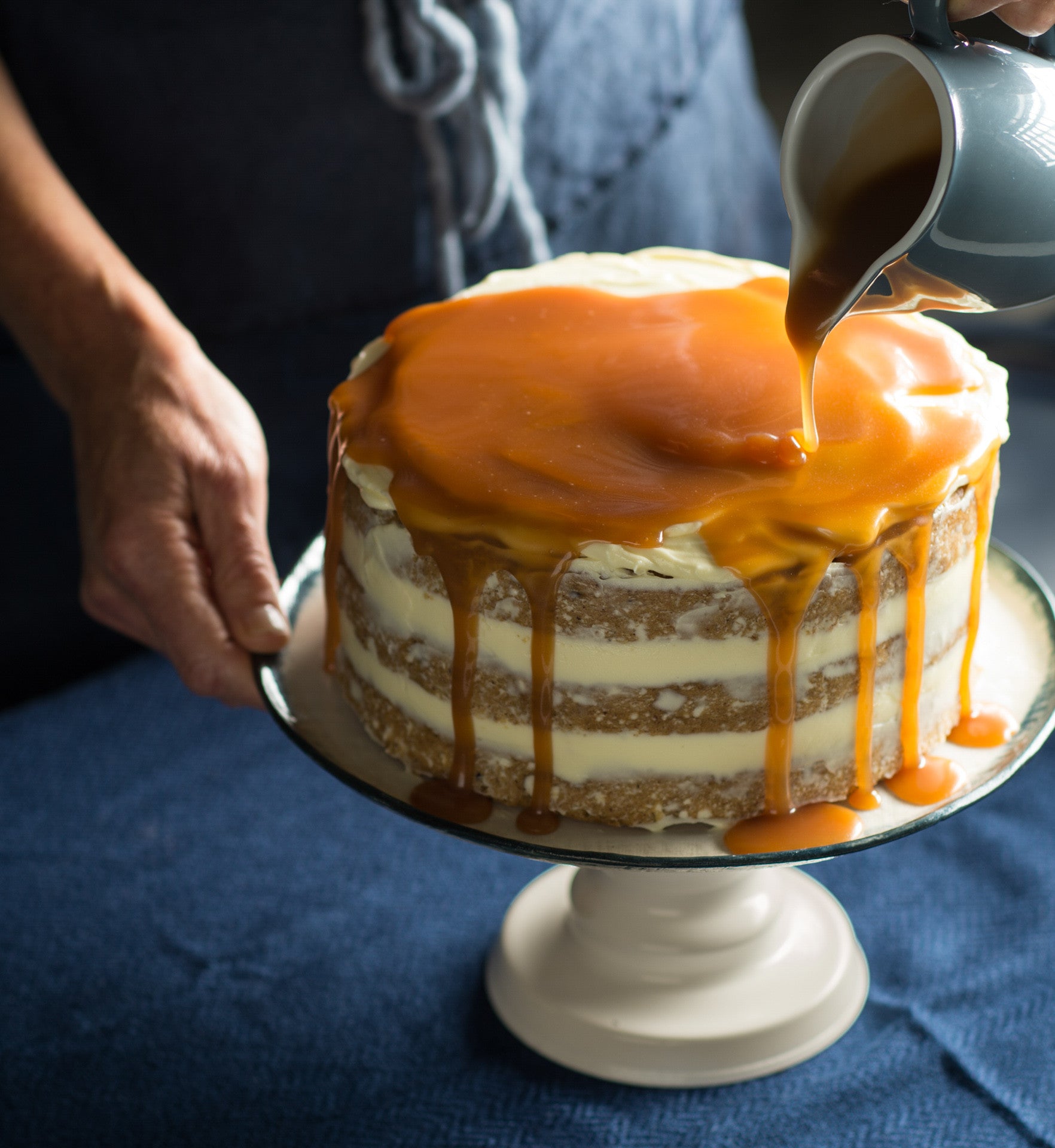
Prep 35min (+1hr cooling time)Bake 25minMakes 12 serves
Layer upon layer, this impressive cake is deceptively simple to make. What’s more, you could call it a hazelnut hummingbird cake with the added bonus of lashings of caramel. Now what’s not to love about that!
Ingredients
Banana and hazelnut cake layers
Melted butter, to grease
300g (2 cups/10½oz) plain flour
3½ teaspoons baking powder
2 teaspoons ground cinnamon
½ teaspoon ground cardamom
220g (1 cup, firmly packed/7¾oz) brown sugar
100g (3½oz) hazelnut meal
60g (⅔ cup/2oz) desiccated coconut
150g (5¼oz) salted butter, melted and cooled
3 eggs, at room temperature, lightly whisked
4 ripe medium bananas (about 200g/7oz each), mashed
2 teaspoons natural vanilla extract or essence
Caramel
165g (¾ cup/5¾oz) caster sugar
60ml (¼ cup/2fl oz) water
150ml (5fl oz) pouring cream
30g (1oz) salted butter, cubed
Cream cheese frosting
250g (9oz) cream cheese, cubed, at room temperature
80g (2¾oz) salted butter, cubed, at room temperature
1 teaspoon natural vanilla essence or extract
185g (1½ cups/6½oz) icing sugar
Method
- To make the cake layers, preheat the oven to 180°C/350°F (160°C/315°F fan-forced). Brush three shallow 20cm/8in round cake tins with the melted butter to grease and line the bases with non-stick baking paper.
- Sift together the flour, baking powder, cinnamon and cardamom into a large bowl. Stir in the brown sugar, hazelnut meal and coconut and stir with a wooden spoon to combine, breaking up any lumps. Make a well in the centre. Use a fork to whisk together the butter, eggs, banana and vanilla until well combined. Add to the dry ingredients and use a spatula or large metal spoon to fold together until just combined.
- Divide the cake mixture evenly among the prepared cake tins, smoothing the surface with the back of a spoon. Bake in preheated oven for 25 minutes, swapping the tins around halfway through baking, until pale golden and a skewer inserted into the centre of the cakes comes out clean. Stand the cakes in the tins for 5 minutes before transferring to wire racks to cool.
- Meanwhile, to make the Caramel, combine the caster sugar and water in a small saucepan and use a wooden spoon to stir over low heat until the sugar dissolves. Increase the heat to medium and bring to the boil. Boil without stirring for about 10 minutes, brushing down the side of the pan with a pastry brush dipped in water to dissolve any sugar crystals, until the mixture turns a deep caramel. Remove immediately from the heat and carefully add the cream and butter. Stir with a wooden spoon until well combined and the caramel is smooth. Return the saucepan to a medium heat if any lumps remain to dissolve them, stirring constantly. Brush a little of the hot caramel over the warm cakes.
- Pour the Caramel into a heatproof bowl or jug and set aside to cool, stirring occasionally this will take about 1 hour).
- Meanwhile to make the Cream Cheese Frosting, use an electric mixer to beat the cream cheese, butter and vanilla until well combined and creamy. With the mixer running, gradually beat in the icing sugar until well combined and smooth. Cover and set aside in a cool spot (but not in the fridge).
- To assemble the cake, spread about ½ cup of the cream cheese frosting over the top of one of the cake layers. Top with another cake layer, another ½ cup frosting and the remaining cake layer. Spread a thin layer of frosting around the outside of the cake so that the cake layers show through. Spread the remaining frosting on top. Pour a generous amount of the caramel over the top of the cake, allowing it to drizzle down the sides. Serve in wedges with the remaining caramel passed separately, if desired.
Baker's Tip
- This cake will keep in an airtight container in the fridge for up to 3 days. Stand at room temperature for 30 minutes before serving.
Photography by Alan Benson.
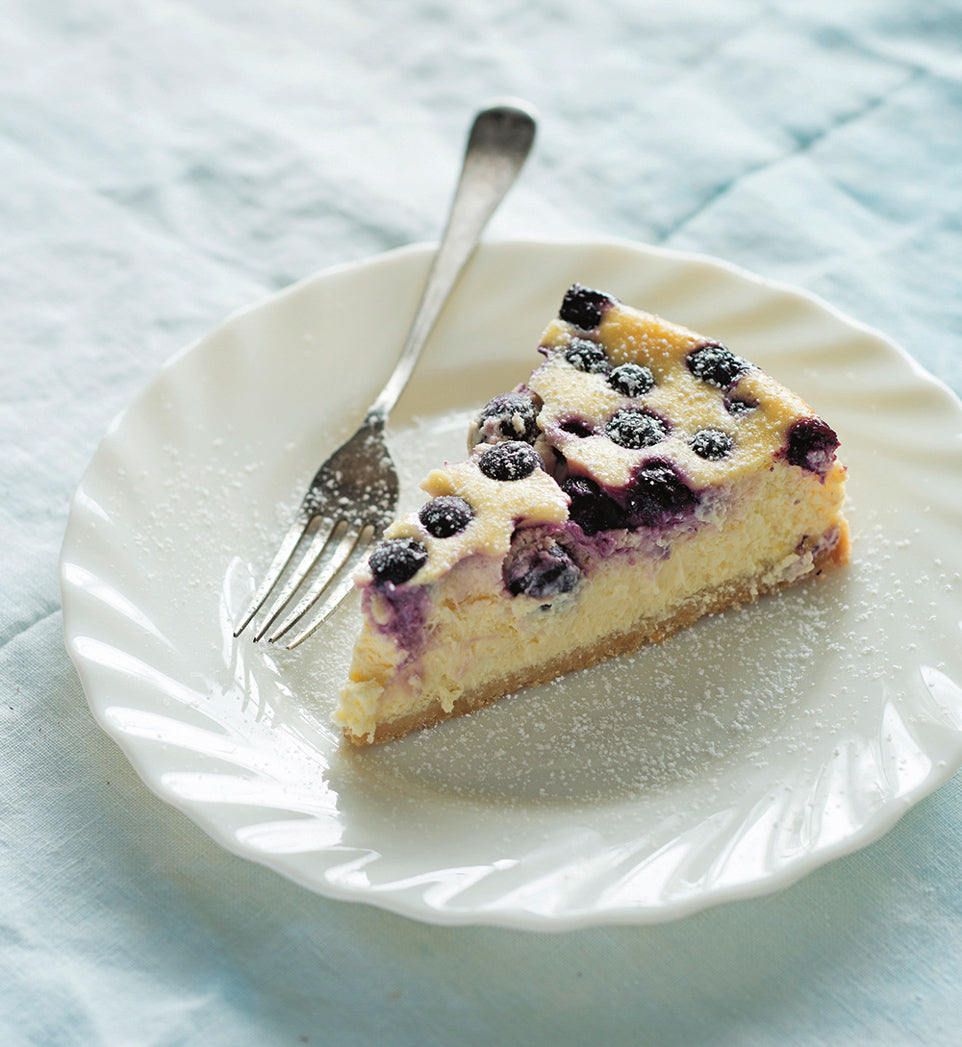
Prep 25min (+ 1hr cooling and 3hr chilling time)Bake 1hr 10minMakes 10 serves
Bringing together sweet blueberries and sour lemons, this simple cheesecake is light but luscious. It's the perfect end to a lazy summer meal.
Ingredients
Melted butter, extra, to grease
375g cream cheese, at room temperature, cubed (see Baker's Tips)
3 eggs, at room temperature
185g (¾ cup) sour cream
125ml (½ cup) thin (pouring) cream
165g (¾ cup) caster (superfine) sugar
1 tablespoon finely grated lemon zest
2 tablespoons freshly squeezed lemon juice
200g fresh or frozen blueberries (see Baker's tips)
Icing sugar, to dust
- 100g plain sweet biscuits
- 60g butter, melted
Method
- Preheat the oven to 150°C. Line the base of a 20cm (8 in) spring-form cake tin with baking paper. Brush the side of the tin with a little melted butter to grease.
- To make the Biscuit base, process the biscuits in a food processor until finely crushed. Add the butter and process until well combined. Sprinkle the mixture over the base of the tin and use the back of a metal spoon or the base of a glass to press down to cover evenly. Put the tin on a baking tray and place in the fridge.
- Clean the food processor bowl and process the cream cheese until smooth. Add the eggs and process until smooth. Add the sour cream, thin cream, sugar, lemon zest and juice and process until well combined and smooth, scraping down the side and base of the bowl when necessary. Pour into the tin over the base. Scatter the blueberries over the top.
- Bake for 1 hour 10 minutes or until the cheesecake is just set but the centre trembles slightly when the tin is shaken gently. Turn off the oven, use a wooden spoon to keep the oven door ajar and leave the cheesecake in the oven for 1 hour (this helps prevent the cheesecake from cracking). Transfer the cheesecake, still in the tin, to the fridge and chill for at least 3 hours or until well chilled. Dust with icing sugar and serve.
Variations
- Orange & Raspberry Cheesecake – Replace the lemon zest and juice with orange zest and juice. Replace the blueberries with fresh or frozen raspberries.
- Blueberry & White Chocolate Cheesecake – Replace the lemon zest and juice with 1½ teaspoons natural vanilla extract or essence. Melt 180g good-quality white chocolate and cool to room temperature. Add to the bowl of the food processor just before transferring the mixture to the tin and process until just combined.
- Individual Lemon & Blueberry Cheesecakes – Line a 12-hole 80ml (⅓ cup) capacity muffin tin with paper cases. Divide the biscuit base, cream cheese mixture and blueberries evenly among the cases. Bake at 160°C for 30 minutes. Cool as per the recipe, then chill in the fridge for at least 1 hour before removing the paper cases and serving.
Baker's Tips
- Having the cream cheese at room temperature means it will easily become smooth and creamy in the food processor. If you use it straight from the fridge it will take longer and you’ll need to scrape the side and base of the food processor frequently so that no lumps are left after processing.
- If using frozen blueberries, use them straight from the freezer – do not thaw.
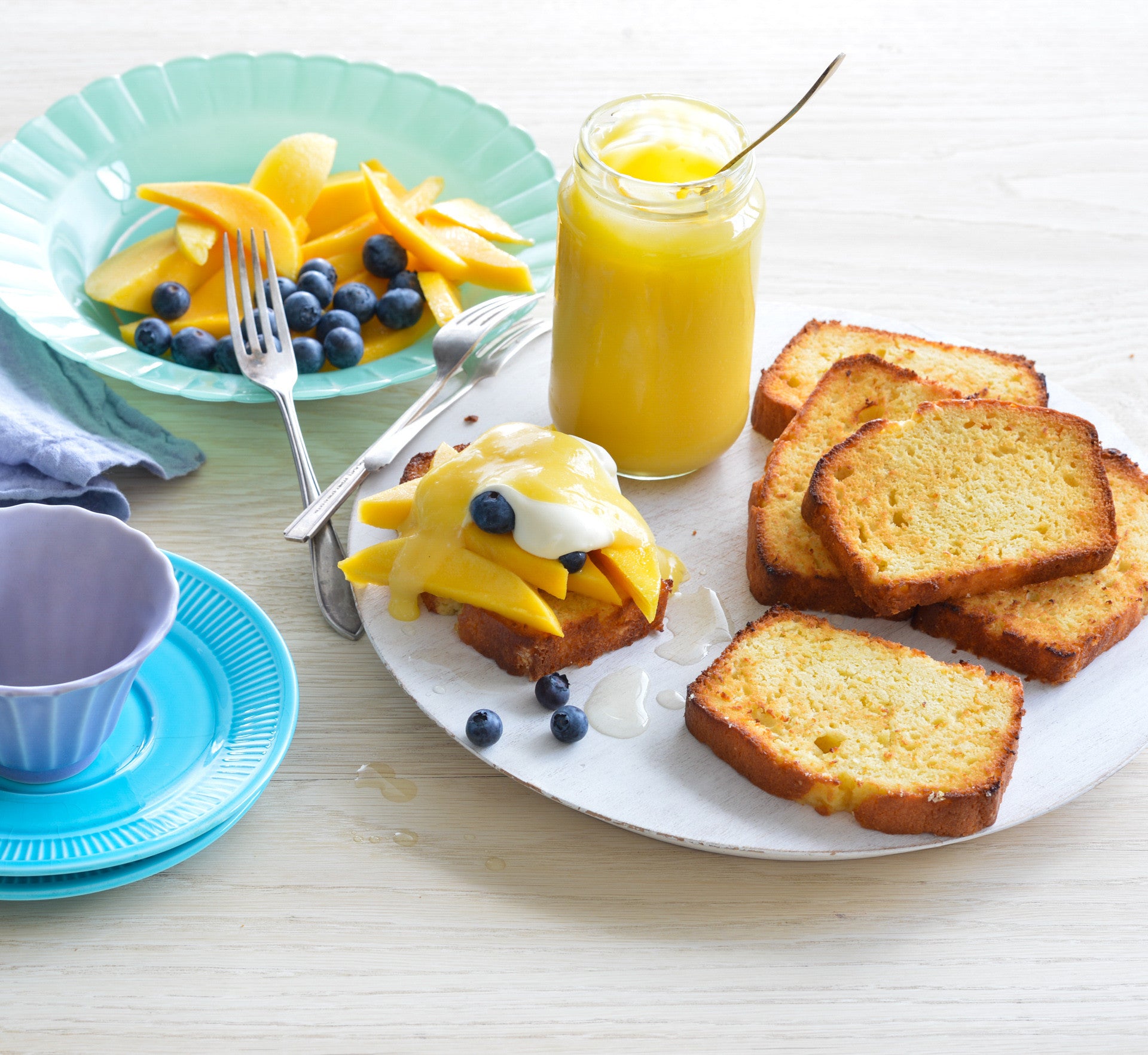
Prep 50min (+30min cooling time)
Bake 50minMakes 8-10 serves
A heavenly layering of mouth-puckering lemon pound cake, curd and syrup, teamed with summer fruits and ‘soured’ cream, this dessert is one for lemon-lovers. The cake is just as delicious served either plain, toasted or chargrilled – just take your pick!
Ingredients
- melted butter, to grease
- 125ml (½ cup) sour cream
- 125ml (½ cup) thickened cream
- 2 x 125g punnets blueberries, to serve
- 2 ripe medium mangoes, sliced, to serve
Lemon buttermilk pound cake
- 125g butter, at room temperature
- 220g (1 cup) caster sugar
- 2 eggs
- 1 tablespoon finely grated lemon zest
- 225g (1½ cups) plain flour
- ½ teaspoon bicarbonate of soda
- 125ml (½ cup) buttermilk
- 1 tablespoon strained fresh lemon juice
Lemon curd
- 125ml (½ cup) strained fresh lemon juice
- 165g (¾ cup) caster sugar
- 3 eggs, whisked and strained
- 100g unsalted butter, cubed, at room temperature
Lemon syrup
- 110g (½ cup) caster sugar
- 160ml (⅔ cup) strained fresh lemon juice
- 2 tablespoons water
Method
- To make the lemon buttermilk pound cake, preheat oven to 180°C (160°C fan-forced). Grease a 9cm x 19cm (base measurement) loaf tin and line the base and long sides with one piece of non-stick baking paper. Use an electric mixer to beat the butter and sugar until pale and creamy. Add the eggs one at a time, beating well after each. Beat in the lemon zest. Sift together the flour and bicarbonate of flour. Combine the buttermilk and lemon juice. On lowest possible speed beat in half the flour mixture and then half the buttermilk mixture until just combined. Repeat with the remaining flour and buttermilk mixtures in two more batches until just combined. Pour the mixture into the prepared tin and smooth the surface with the back of a spoon. Bake in preheated oven for 50 minutes or until a skewer inserted into the centre comes out clean. Leave to stand in the tin for 5 minutes before transferring to a wire rack to cool (this will take about 30 minutes).
- To make the lemon curd, combine the lemon juice, sugar and eggs in a medium heatproof bowl and place over a saucepan of simmering water (make sure the bowl doesn’t touch the water). Stir with a wooden spoon for 10-12 minutes or until the mixture thickens to a consistency similar to pouring cream (do not boil). Remove the bowl from the saucepan and gradually stir in the butter until the butter is evenly incorporated and the curd is smooth. Cover with plastic wrap (see Baker’s tips) and place in the fridge to chill.
- To make the lemon syrup, combine the sugar, water and lemon juice in a small saucepan and stir over medium heat until the sugar dissolves. Bring to the boil and boil for 3 minutes or until reduced slightly.
- To serve, combine the cream and sour cream in a medium bowl and use a balloon whisk to whisk until soft peaks form. Transfer to a serving bowl. Preheat a chargrill pan on high (see Baker’s tips). Cut the cake into 1.5 cm-thick slices and toast in a toaster until lightly golden and warmed through. Transfer to a plate and place in the centre of the table with the curd, syrup, fruit and cream for guests to assemble their own dessert.
Baker's Tips
- The Lemon buttermilk pound cake will keep in an airtight container at room temperature for up to 2 days.
- If making the curd ahead of time, you can transfer it straight into a clean airtight jar, cover with an airtight lid and place in the fridge. It will keep in an airtight jar or container in the fridge for up to 1 week.
- The lemon syrup will keep in an airtight jar or container in the fridge for up to 2 weeks.
- The cake can be also toasted in a sandwich press or in a toaster until golden.
- The combined whipped cream and sour cream can be replaced by scoops of good-quality vanilla ice-cream if desired.
Photography by Alan Benson.
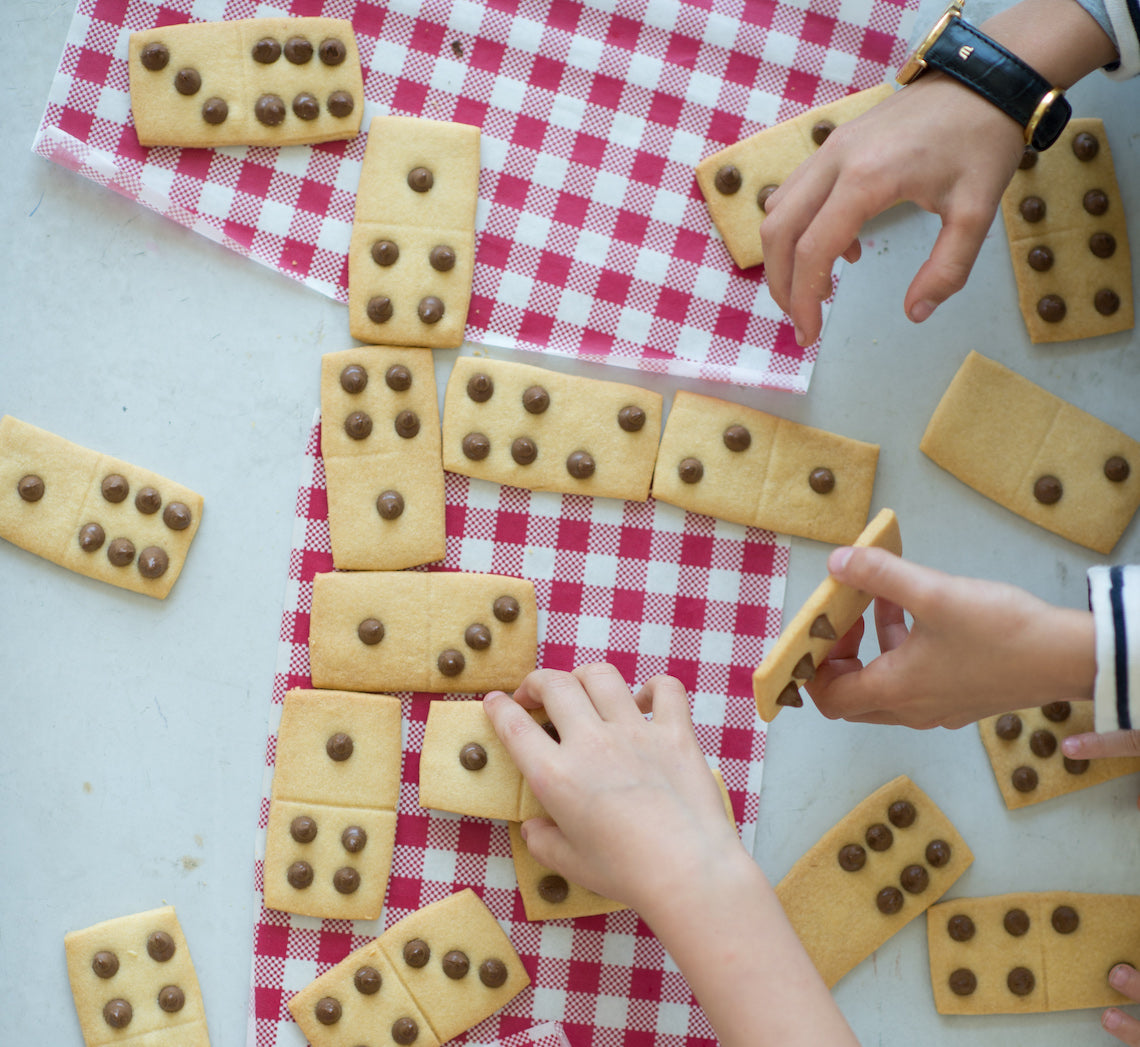
Prep 25min (+30min chilling and 30min cooling time)Bake 25minMakes about 40
Sipping on malted milk milkshakes and playing dominos is a vivid childhood memory. These biscuits combine the two and kids will love not only creating them, but also playing with them as they snack — all you need is a glass of milk!
Ingredients
250g butter, softened slightly
110g (½ cup) caster sugar
1 egg yolk
375g (2½ cups) plain flour
60g (½ cup) malted milk powder
Dark or milk Choc Bits (chocolate chips), to decorate
Method
- Preheat the oven to 160°C (140°C fan-forced). Line two large oven trays with non-stick baking paper.
- Use an electric mixer to beat the butter and sugar until smooth and just combined. Add the egg and beat until well combined.
- Add the flour and malted milk powder to the butter mixture and beat on low speed until just combined evenly and a dough forms.
- Turn the dough onto a lightly floured surface and knead lightly and briefly until it just comes together. Divide the dough into two portion. Use a lightly floured rolling pin to roll out one portion to 5mm thick. Use a large sharp knife and a ruler to cut the dough into 4cm x 8cm rectangles; re-rolling any off cuts as necessary. Use the knife to make a shallow indent across the middle of each biscuit. Place on the lined oven trays, leaving about 2cm between each. Press the Choc Bits into the biscuits to resemble dominos. Repeat with the remaining dough portion and Choc Bits. Place in the fridge to chill for 30 minutes.
- Bake in preheated oven for 25 minutes, swapping the trays around after 10 minutes, or until pale golden and cooked through. Cool on the trays.
Baker's Tips
- These biscuits will keep in an airtight container at room temperature for up to 1 week.
This recipe is from Anneka's SBS Food online column, Bakeproof: Kids in the Kitchen.
CLICK HERE for more Bakeproof recipes.
Photography by Alan Benson.






